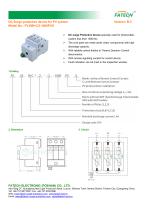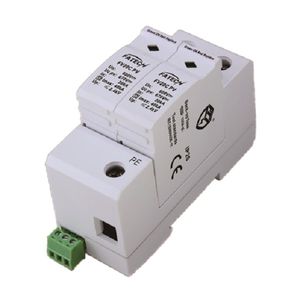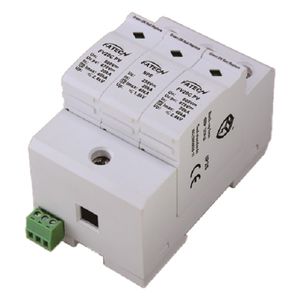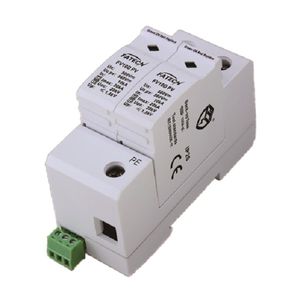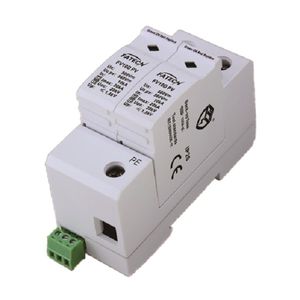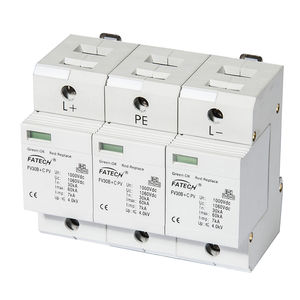
- Electricity - Electronics
- Switch and Relay
- Remote signaling surge arrester
- FATECH ELECTRONIC (FOSHAN) CO., LTD
- Company
- Products
- Catalogs
- News & Trends
- Exhibitions
Type 1 + 2 surge arrester FV30B+C/3-1000 PV(S)remote signalingfor photovoltaïc installationswith fault indication


Add to favorites
Compare this product
Characteristics
- Type
- type 1 + 2
- Applications
- remote signaling, for photovoltaïc installations
- Other characteristics
- with fault indication, 3-pole, low-voltage, DC, DIN rail, plug-in
- Voltage
Min.: 0 V
Max.: 1,200 V
1,000 V
- Primary current
Min.: 0 A
Max.: 60,000 A
30,000 A
Description
-DC surge protective devicespecially used for photovoltaic system less than 1000Vdc.
-The core parts are metal oxide varistor components with high discharge capacity.
-With Reliable control thanks to Thermo Dynamic Control disconnector.
-With remote signaling contact for control device.
-Fault indication via red mark in the inspection window.
SPD protection conforms to EN50539-11/IEC61643-31 - Type 1+2
SPD installation type conforms to EN50539-11/IEC61643-31 - ClassI+II
Protection level conforms to DIN VDE0675-6 - B+C
Type of Network - Photovoltaic systemsDC side
Protectionmode - (+/-)-PE, (-/+)-PE
Standby power consumption PC - ≤25 mVA
Maximum discharge current (8/20μs) Imax - 50 kA
Nominal discharge current (8/20μs) In - 25 kA
Impuse discharge current (10/350μs) Iimp - 5 kA
Voltage protection level Up - ≤3.8 kV
Isolation resistance Risol - >1000 MΩ
Response time tA - ≤25 ns
Remote control contact - YES
Disconnection indicator - Mechanical indicator
(Green: OK, Red: Replace)
Minimum area of connecting cable - 6mm2
Maximum area of connecting cable - 35mm2
Installation location - Inside
Mounting type - 35mm DIN rail acc. to EN 60715
Color - Gray
Degree of protection - IP20
Housing material - UL94V-0
Ambient temperature - -40°C ~+80°C
Altitude - ≤2000 m (amsl (above mean sea level))
Permissible humidity - 30%~90%
Catalogs
FV30B+C/3-1000PVS 36mm
2 Pages
FV30B+C/3-1000PVS 18mm
3 Pages
Other FATECH ELECTRONIC (FOSHAN) CO., LTD products
On-grid surge protection
Related Searches
- Surge protector
- DIN rail surge protector
- Type 2 surge protector
- Low-voltage surge protector
- Power supply surge protector
- Type 1 surge protector
- AC surge protector
- Multipole surge protector
- Plug-in surge protector
- Remote signaling surge protector
- Monobloc surge protector
- Compact surge protector
- Type 3 surge protector
- Surge protector with fault indication
- Three-phase surge protector
- Class II surge arrester
- Single-phase surge protector
- 2-pole surge protector
- Telecommunications surge protector
- DC surge protector
*Prices are pre-tax. They exclude delivery charges and customs duties and do not include additional charges for installation or activation options. Prices are indicative only and may vary by country, with changes to the cost of raw materials and exchange rates.



